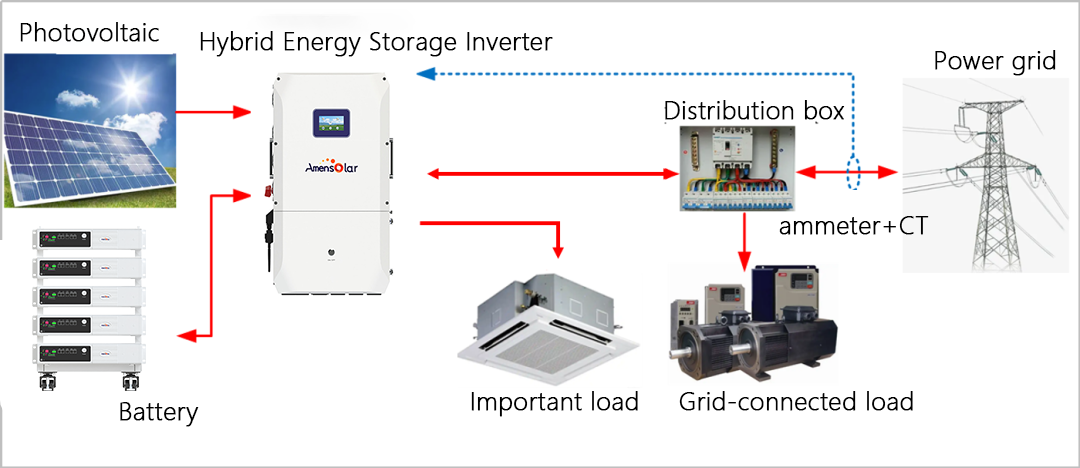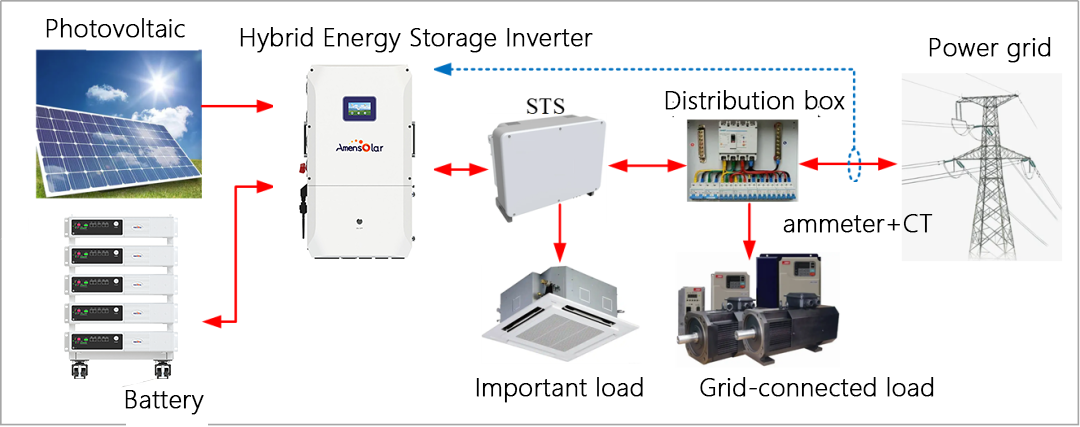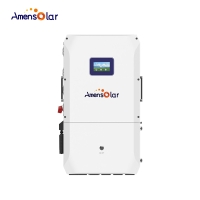Energy Storage System Switching Devices
Energy storage systems can provide backup power for both grid-connected and off-grid operations. The power switching device is one of the key components that ensure continuous and reliable power supply. Here are the most common types of switching methods:
01 Manual Transfer Switch
When the grid power goes out, the energy storage system enters an islanding protection state. You manually disconnect the energy storage system from the grid and switch the system to off-grid mode (V/F), which then starts providing backup power to the load.
When the grid power is restored, you close the switch again, and the system switches to grid-connected mode (P/Q) to supply power to the load once more.

When to Use:
This method is suitable for simple applications where manual control is needed, like in homes or small businesses.
02 ATS (Automatic Transfer Switch)
An ATS is a device used to automatically switch between power sources. In a power system, it’s common to have multiple power sources connected to ensure reliable electricity supply.

The ATS automatically switches between the main power supply and a backup power source (such as an energy storage system or generator). The switching time is usually just a few seconds. If one power source fails or goes out, the ATS quickly switches the load to the backup source, ensuring there’s no interruption in power.
How It Works:
When the grid loses power, the energy storage system enters islanding protection. The ATS then switches to a backup power source, like a diesel generator. Once the grid comes back online, the diesel generator starts running, and the energy storage system resumes operation.
03 STS (Static Transfer Switch)
An STS is another type of switch used for power source switching. It can intelligently and rapidly disconnect the grid from the microgrid and switch power circuits, doing this in milliseconds.
When the grid is functioning normally, the load is connected to both the grid and the battery. If there’s a grid failure, the STS disconnects the grid and switches to the energy storage system (like solar or battery) to supply power to the load. When the grid is back online, the STS reconnects.

Amensolaress Solution:
For small-scale energy storage, our STS module is integrated into the PCS, making wiring simpler. For larger systems (≥16kW), we use an external STS module to improve the power supply reliability and provide off-grid backup power.

How It Works:
When the grid goes down, the STS automatically disconnects and informs the PCS. In less than 10ms, the PCS switches to V/F mode to supply voltage and frequency to the load. Once the grid is back, the STS detects it, completes the handshake, and the PCS switches from off-grid mode back to grid-connected mode while instructing the STS to reconnect. This seamless switching between the STS and PCS ensures uninterrupted backup power for the load.

Additional Notes
The time it takes to switch between grid-connected and off-grid modes is a key factor in assessing the performance of a backup power system, especially in scenarios where power interruptions can cause major issues.
EPS Switching Time:EPS switching time typically takes 2-10 seconds and is relatively slow, as it depends on mechanical relays or contactors. ATS switching is an EPS-level switch.
UPS Switching Time:UPS switching time is usually in the millisecond range (0-20ms).
A 20ms interruption can be noticeable by certain loads, like TVs or desktop computers.
A 10ms switch ensures most loads remain uninterrupted, which is typical for backup UPS systems.
A 4ms switch can achieve seamless power for sensitive devices, including high-end servers and medical equipment, which is common for online UPS systems.
In Summary
In real-world energy storage systems, ATS and STS can be configured together to provide higher reliability and flexibility. For users with higher power demands, our 16kW inverter solution offers a reliable, seamless backup power system that meets most residential and commercial needs.

 N3H-X16US 16KW | Split Phase |...
N3H-X16US 16KW | Split Phase |...  N3H-X12US 12KW | Split Phase |...
N3H-X12US 12KW | Split Phase |...  N3H-X10US 10KW | Split Phase |...
N3H-X10US 10KW | Split Phase |...  N3H-X8US 8KW | Split Phase | ...
N3H-X8US 8KW | Split Phase | ...  N3H-X5US 5KW | Split Phase | ...
N3H-X5US 5KW | Split Phase | ...  N1F-A3US 3KW | Split Phase | ...
N1F-A3US 3KW | Split Phase | ...  N1F-A12US 12KW | Split Phase |...
N1F-A12US 12KW | Split Phase |...  N1F-A6.5US 6.5KW | Split Phase ...
N1F-A6.5US 6.5KW | Split Phase ...  N1F-A6.2P 6.2KW | Single Phase...
N1F-A6.2P 6.2KW | Single Phase...  N1F-A6.2E 6.2KW | Single Phase...
N1F-A6.2E 6.2KW | Single Phase...  AMF16000 51.2V | 16KWH | Floo...
AMF16000 51.2V | 16KWH | Floo...  AMW10240 51.2V | 10.24KWH | W...
AMW10240 51.2V | 10.24KWH | W...  LFP 16kWh / LV 51.2V | 16KWH | Floo...
LFP 16kWh / LV 51.2V | 16KWH | Floo...  S52300 51.2V | 16KWH | Stac...
S52300 51.2V | 16KWH | Stac...  S52200 51.2V | 10.24KWH | S...
S52200 51.2V | 10.24KWH | S...  AML12-200 12.8V Series LifePo4...
AML12-200 12.8V Series LifePo4...  AML12-100 12.8V Series LifePo4...
AML12-100 12.8V Series LifePo4...  AML12-120 12.8V Series LifePo4...
AML12-120 12.8V Series LifePo4...  AML12-150 12.8V Series LifePo4...
AML12-150 12.8V Series LifePo4... 